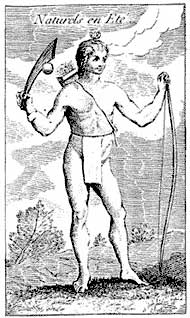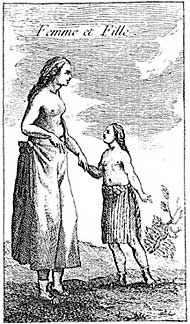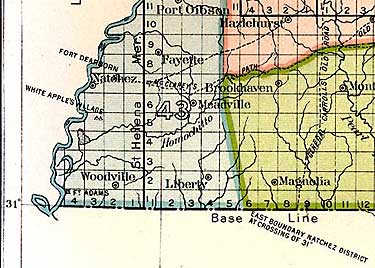The Munsons of Texas — an American Saga
Inset 5
THE STORY OF THE NATCHEZ INDIANS

Le Page Du Pratz drawings
courtesy of the Mississippi
Dept. of Archives and History
When Sieur de la Salle stopped at the high bluffs of the lowr Mississippi in 1682, he met some Natchez Indians from a nearby village. These Indians possessed an intense pride and a distinctive culture. Their religion was a complex version of sun worship, based upon the belief that their leaders were descendants of the Sun God, hence the title of "Sun". The monarch, called the "Great Sun", succeeded to his throne as the eldest son of the female Sun nearest kin to the mother of the last Great Sun. As chief of chiefs, he ruled with a iron hand from his Grand Village on St. Catherine Creek.
Within months after Sieru d'Iberville founded a French colony on Biloxi Bay in 1699, Jesuits were at work among the Natchez. In 1713 a trading post was established at the landing beneath the bluffs. Trouble immediately followed. In 1714 the Natchez murdered four French traders, and in the next fifteen months they killed other traders, stole their goods, and pillaged the warehouse. The French threatened armed reprisals, but in 1716 a treaty was signed in which the Natchez agreed to compensate the French by supplying lumber and labor for the construction of a fort on the bluff. The fort was named "Rosalie" for the wife of the Count de Pontchartrain. French planters came in 1717, and within a few years several large plantations were producing wheat and fine tobacco. Hatred for the Frenchmen grew among the Indians. Deeply resented were sexual abuse of the Natchez women, unjust treatment of the field laborers, encroachment upon Indian farming areas, the proximity of French settlements to the sacred Grand Village, and flagrant disrespect for ancient tribal mores. French abuses led to Indian retaliations, and in 1723 French Commandant Bienville led 500 soldiers against the Natchez, burning two villages, destroying their crops, and exacting the heads of twelve leaders.

Le Page Du Pratz drawings
courtesy of the Mississippi
Dept. of Archives and History
In 1729 Commandant Dechepare was assigned to Natchez, and he proved to be a brutal, heavy-drinking tyrant interested solely in exploiting the settlers and Indians for his personal gain. He soon ordered the Natchez of the White Apple Village on Second Creek to vacate their lands and to pay debts to him in grain and fowl. A secret council was called to answer this threat. Settlers and armymen warned Dechepare that a conspiracy was brewing, but he scoffed at their timidity. Dechepare naively questioned the Great Sun, who was the son of the early Jesuit missionary St. Cosme, and the chief assured him that no uprising was considered. At nine o'clock the next morning, November 28, 1829, the Natchez appeared at Fort Rosalie bearing gifts and asking for a loan of guns and ammunition for a grand hunt. When they gained admission to the fort, they suddenly opened fire on the surprised Frenchmen. This was the signal for other groups to attack the settlements at St. Catherine Creek and Second Creek. At least 236 French men, women, children, and slaves died in the massacre, and some sources put the figure as high as 2,000. Dechepare was forced to witness the piling of decapitated heads in front of the new warehouse where the Great Sun sat in triumph, and then he was shot. It was later written, "This is how one man's faults can . . .cause a whole colony to be lost."
French reprisal was swift. They incited the Choctaw against the Natchez, and in January of 1830 the Choctaw attacked and did fearful damage. In February French reinforcements arrived. After besieging two Indian forts along St. Catherine Creek for two weeks, the French awoke one morning to find that the Natchez had slipped across the Mississippi River during the night. The Natchez escaped into a wild region of swamps, but the French continued to pursue them. Some were captured and deported to Santo Domingo, and the remainder were continually harassed. Gradually the remaining Natchez splintered into small elements and joined the Cherokee and Creek Indians, and disappeared as a tribe. The French then essentially abandoned Natchez, and it lay inactive until the British arrived in 1763. Today the original Grand Village of the Natchez in the outskirts of Natchez, Mississippi, is a state park. Much of the village and the life of the Natchez are reconstructed and displayed there.

